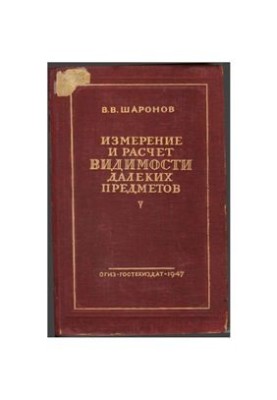Measuring and calculating the visibility of distant objects
 Instant download
Instant download
after payment (24/7)
 Wide range of formats
Wide range of formats
(for all gadgets)
 Full book
Full book
(including for Apple and Android)
The Host [D.T.] 1947. Moscow, Leningrad . - 284 s. Foreword by . The problem of visibility and how to solve it . The doctrine of visibility and its current state . Practical significance of visibility issues. Factors determining visibility. Conditions for the visibility of distant objects. Visibility and opening range. — Literature to Chapter I. Horizontal Visibility Theory . Historical Review . Vision properties that determine visibility. Brightness and color of natural objects . Natural Landscape Contrasts . Critical turbidity and contrast difference. Weakening of the light beam in the surface layer of air . The theory of the visibility of self-luminous objects at night . Dispersion of light in the atmosphere . Light-air formula. Horizontal Daytime Visibility Theory . Literature to Chapter II. Theory of Visibility Meters. Visibility meter and its purpose. Classification of Visibility Meters. The main provisions of the theory of the meter of visibility, working on the principle of artificial turbidity . Application of the Visibility Meter to the Measurement of General Visibility Conditions. Measurement of the difference and threshold of contrast sensitivity of vision . Weather measurement of luminance and visibility coefficient. Observation of remote objects (strict theory). Approximate methods for determining air transparency and visibility characteristics from observations of distant objects. Night observation of self-luminous objects . Saussure's Diaphanometer and its Photometric Theory. Literature to Chapter III. Visibility meters based on the application of the absorbing medium. Principles of observation by the method of quenching and by the method of equality of contrasts . Absorbing filter theory. Photometric wedge. Grading filters and wedges. Katz and Tihanovsky Visibility Meters . Lakish and Moss Visibility Meter . Gold's Wedge Device . Forest Fire Visibility Meter Bayram. Photometric Screen Piskun. Sharon's Diaphanoscope . Literature to Chapter IV. Visibility meters based on the application of a scattering medium. Wigand and Dunnmeyer Visibility Meters. Gamba and Bennett Visibility Meters. Criticism of Wigand's Method. Laboratory studies and photometric theory of visibility meters with turbid environment. General assessment of the visibility meter with an artificial turbid environment and the possibility of implementing the additivity principle in such a device . —Literature to Chapter V. Visibility meters based on optical coupling of two images. Jones Visibility Meter . Dymkomer Sharonova I type . Dymkomer Sharonova II type . Piskun's VP-3 and Universal Visibility Meter of Gulnitsky and Anisimov. Night Visibility Meters Sytinskaya . Vision meters with a split pupil of the telescopic system. Literature to Chapter VI. Measurement and Calculation of Visibility . Numerical data defining the observation conditions. Determination of illustrative visibility range by means of a visibility meter. Determination of the coefficient of extinction and the luminance factor by photometric measurement of the brightness of the air haze. Determination of illustrative range of visibility by measurement of extinction. Determination of illustrative range of visibility by nephelometric means. Definition of illustrative range of visibility without tools. Comparative advantages and accuracy of various methods for determining the illustrative range of visibility . Measurement of weather coefficient, brightness and variability coefficients. Calculate horizontal visibility by day. Counting horizontal visibility at night. Literature to Chapter VII.
LF/690183225/R
Data sheet
- Name of the Author
- Шаронов В.В.
- Language
- Russian


















